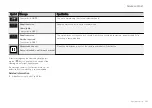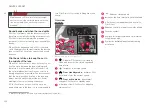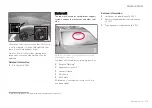
DRIVER SUPPORT
316
Automatic braking with Pilot Assist
Pilot Assist has a special brake function in slow
traffic and while stationary.
Brake function in slow queues and
while stationary
For shorter stops in connection with inching in
slow traffic or at traffic lights, driving is automati-
cally resumed if the stops do not exceed
approx. 3 seconds - if it takes longer before the
vehicle in front starts moving again then Pilot
Assist is set in standby mode with automatic
braking.
–
Pilot Assist is reactivated in the following
way:
•
Press the steering wheel button
.
•
Depress the accelerator pedal.
> Pilot Assist resumes following the vehicle
ahead if it starts moving forward within
6 seconds.
Pilot Assist can hold the car stationary for a
maximum of 5 minutes - then the parking
brake is applied and the function is disen-
gaged.
Before Pilot Assist can be reactivated, the
parking brake must be released.
Cessation of automatic braking
In some situations, automatic braking ceases on
coming to a standstill and Pilot Assist is set in
standby mode. This means that the brakes are
released and the car may start to roll - the driver
must therefore intervene and brake the car him-
self/herself to keep it stationary.
This may take place in the following situations:
•
the driver puts his/her foot on the brake
pedal
•
the parking brake is applied
•
the gear selector is moved to
P
,
N
, or
R
posi-
tion
•
the driver sets Pilot Assist in the standby
mode.
Automatic activation of parking brake
In certain situations, the parking brake is applied
in order to keep the car stationary.
This takes place if Pilot Assist is holding the car
stationary with the foot brake and:
•
the driver opens the door or takes off his/her
seatbelt
•
Pilot Assist has kept the car stationary for
more than approx. 5 minutes
•
the brakes have overheated
•
the driver switches the engine off manually.
Related information
•
Limitations of Pilot Assist
The Pilot Assist function may have limitations in
certain situations.
The Pilot Assist function is an aid which can help
the driver in many situations. But the driver is at
all times responsible for maintaining a safe dis-
tance to surrounding objects and a correct posi-
tion in the lane.
Summary of Contents for S90 TWIN ENGINE
Page 1: ...S90 T W I N E N G I N E OWNER S MANUAL ...
Page 2: ......
Page 17: ...15 ALPHABETICAL INDEX Alphabetical Index 645 ...
Page 18: ......
Page 19: ...OWNER INFORMATION ...
Page 28: ......
Page 29: ...YOUR VOLVO ...
Page 43: ...SAFETY ...
Page 76: ......
Page 77: ...DISPLAYS AND VOICE CONTROL ...
Page 146: ......
Page 147: ...LIGHTING ...
Page 161: ...WINDOWS GLASS AND MIRRORS ...
Page 177: ...SEATS AND STEERING WHEEL ...
Page 191: ...CLIMATE ...
Page 223: ...KEY LOCKS AND ALARM ...
Page 243: ...KEY LOCKS AND ALARM 241 Country Area Type approval Oman Serbia ...
Page 246: ... KEY LOCKS AND ALARM 244 Country Area Type approval Oman Serbia ...
Page 266: ......
Page 267: ...DRIVER SUPPORT ...
Page 403: ...HYBRID INFORMATION ...
Page 424: ......
Page 425: ...STARTING AND DRIVING ...
Page 484: ......
Page 485: ...SOUND MEDIA AND INTERNET ...
Page 539: ...WHEELS AND TYRES ...
Page 565: ...LOADING STORAGE AND PASSENGER COM PARTMENT ...
Page 577: ...MAINTENANCE AND SERVICE ...
Page 629: ...SPECIFICATIONS ...
Page 661: ......
Page 662: ...TP 25059 English Int AT 1746 MY18 Copyright 2000 2017 Volvo Car Corporation ...
















































